Prototype vs MVP: Choosing the Right Approach for Product Validation


In the world of product development, one of the most critical decisions a startup or business faces is whether to create a prototype or a Minimum Viable Product (MVP). Both play crucial roles in the development process, but choosing between the two can be challenging, especially when the stakes are high and resources may be limited.
When developing a new product, you must balance various priorities: time to market, budget, user feedback, and overall project goals. A prototype is often the first step, allowing you to test and refine your ideas early on. In contrast, an MVP is designed to test your product’s viability with real users and validate market demand before fully investing in development.
The decision to build a prototype or MVP depends on what you aim to achieve at different stages of your product development cycle. Whether you’re focused on conceptualization, design, or testing core features, understanding the differences between a prototype and MVP is vital to making the right choice for your product’s success. This blog will break down the key differences, benefits, and use cases for both prototypes and MVPs, helping you decide which path is best suited for your product’s journey. By the end of this guide, you’ll have a clearer understanding of how to leverage each approach to maximize your product’s chances of success in the competitive market.
A prototype is an early model or sample of a product that is built to test, validate, or demonstrate its concepts and features. It serves as a rough draft that represents the visual and functional aspects of the product but is not intended to be a fully functioning product. Prototypes are often used in the early stages of product development to test ideas, gather feedback, and iterate on the design before a full-scale product is developed.
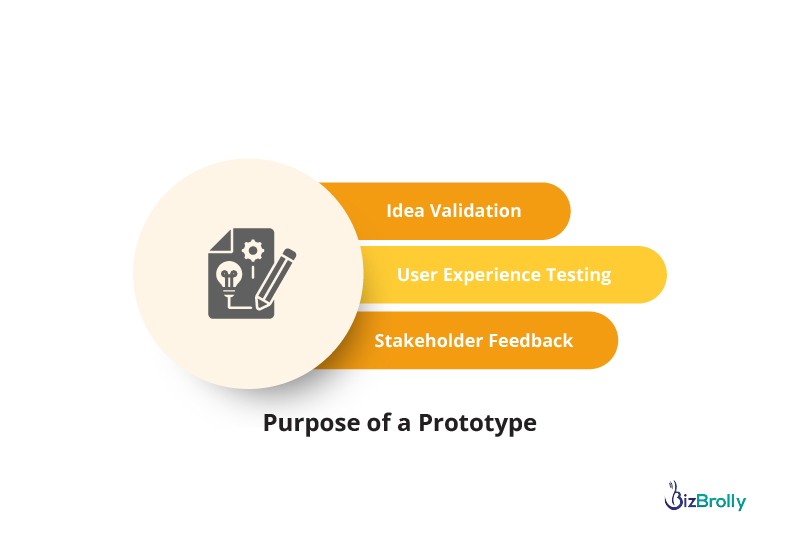
Prototypes allow designers, developers, and stakeholders to test and validate their ideas. It helps visualize how a product will function and look, providing a tangible representation of an idea before significant resources are invested in development.
Prototypes are ideal for testing the product’s user interface (UI) and user experience (UX). They provide a glimpse into how users will interact with the product and allow designers to fine-tune the user experience before building the final product.
Prototypes are also used to get early feedback from stakeholders, including investors, team members, and potential customers. These insights help in refining the product and aligning it with the target audience’s needs.
Low-Fidelity Prototypes: These are basic models, often paper sketches or wireframes, that are quick and inexpensive to produce. They’re used to convey basic concepts and user flows.
High-Fidelity Prototypes: These are more refined and interactive, resembling the final product more closely. High-fidelity prototypes are often built with software tools or other resources that simulate the actual user interface and interaction.
Increased Clarity: A prototype helps designers and developers understand the product’s functionality and how different features interact. This clarity reduces ambiguity in the design phase.
Early Issue Identification: Since a prototype helps test the product’s functionality, it can help identify potential issues in design and usability early on, saving time and resources in the long run.
Improved Communication: Prototypes allow teams to communicate their ideas effectively. Stakeholders, investors, and team members can get a clear understanding of the concept through visual models.
Software Development: A clickable wireframe or mockup of a mobile app that shows how users will interact with different features.
Consumer Products: A 3D printed model of a new physical gadget to evaluate design ergonomics and functionality.
A Minimum Viable Product (MVP) is the most basic version of a product that contains only the core features necessary to meet the needs of early adopters and test the product’s value in the market. The key to an MVP is that it is functional and can be used by real users to solve a problem or fulfill a need, but it is stripped down to its essential features to speed up the launch process and reduce costs.
An MVP is not about creating a perfect product, but rather a first version of the product that can help validate product-market fit, test assumptions, and gather real-world feedback from users. It’s an early release with just enough features to satisfy the initial users and gather data for future iterations.
The primary purpose of an MVP is to test the viability of a product idea in the market with real users. By launching the MVP, businesses can validate whether there’s a demand for the product, and whether users are willing to engage with it.
MVPs are designed to be released to the market quickly so that real-world feedback can be gathered. This helps businesses understand which features users value most, which ones are unnecessary, and what improvements can be made.
Since an MVP focuses on essential features, it’s generally quicker and more cost-effective to develop compared to a fully-featured product. This allows businesses to invest fewer resources upfront while still gaining valuable insights.
By launching an MVP, businesses reduce the risk of investing significant time and money into a product that may not meet the needs of the target market. The MVP helps verify the product concept before full-scale development.
Core Functionality: The MVP includes only the essential features that solve the core problem of the target audience. These features are often the ones that differentiate the product from other market solutions.
Scalability: While the MVP is a minimal version, it is still designed in a way that allows for future scaling and expansion as the product evolves.
User Testing: The MVP is developed with the intention of observing how real users interact with it. This is a critical step in the product development cycle, helping businesses understand what works and what needs improvement.
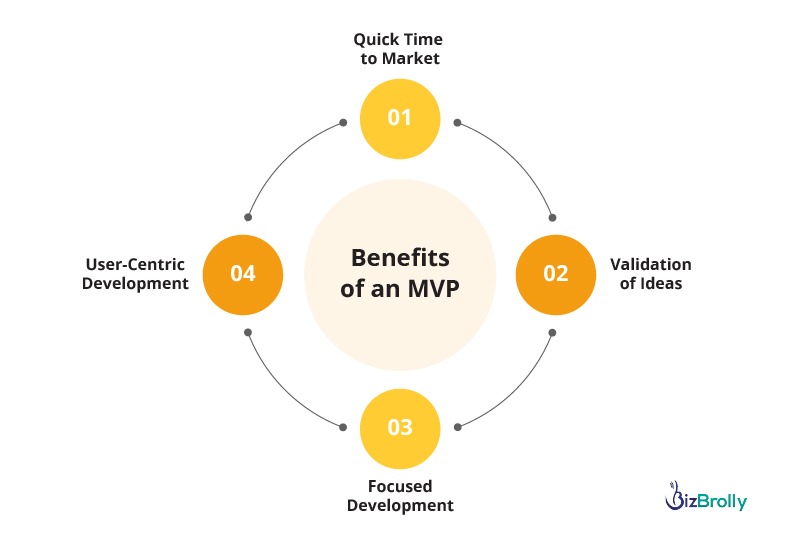
Quick Time to Market: The MVP approach allows businesses to get their product to market quickly, making it easier to test the waters and refine the offering.
User-Centric Development: The MVP is built around user feedback, allowing businesses to continuously improve the product based on actual user experience rather than assumptions.
Focused Development: By concentrating only on essential features, an MVP eliminates unnecessary complexity and ensures the product addresses the core pain points of users.
Validation of Ideas: An MVP helps determine whether the product solves a real problem and whether users are willing to pay for it, providing critical insights before investing heavily in development.
Dropbox: Dropbox’s MVP was a simple video demonstration of how the product would work. Instead of building a fully functional product, they validated their idea by showing potential users what the service would offer. This helped gauge interest before investing in development.
Airbnb: In its early days, Airbnb was a simple MVP that allowed people to rent air mattresses in their homes. The initial version of the platform was very basic, but it was enough to demonstrate the market demand and iterate on user feedback.
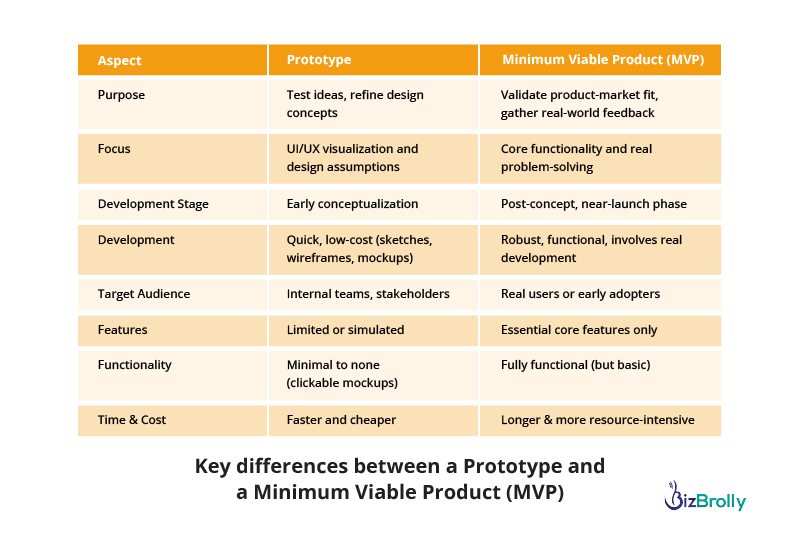
Understanding the distinction between a prototype and a Minimum Viable Product (MVP) is essential for making the right decision in the product development process. Both serve different purposes and are used at different stages of development, but they share the common goal of refining a product and ensuring it meets the market’s needs.
Prototype: A prototype is primarily used for testing concepts and ideas. Its goal is to visualize a product’s design, user interface (UI), and user experience (UX) before the actual product is built. It allows stakeholders to get a feel for the product’s look and functionality but does not include complete or fully functioning features.
Goal: To test ideas, refine design concepts, and get feedback on aesthetics and usability.
Focus: On visualizing design and testing assumptions.
MVP: An MVP, on the other hand, is a functional product with the core features that are necessary to solve a problem and engage users. Its purpose is to gather real-world feedback from actual users, test market demand, and validate the product concept. Unlike a prototype, an MVP is a working product, even if it’s minimal.
Goal: To validate product-market fit and gather feedback to iterate and improve.
Focus: On core functionality and solving a real problem for users.
Prototype: Typically used in the early stages of product development, a prototype is created to visualize and iterate on ideas. It’s more about exploration and design and is not intended for actual user testing in the market.
Stage: Early conceptualization.
Development: Quick and cost-effective, often with basic tools like sketches, wireframes, or mockups.
MVP: An MVP comes after the prototype stage and represents the first version of the product that is actually usable in the market. It includes the core features necessary for the product to function in a real-world setting.
Stage: Post-conceptualization and closer to launch.
Development: More robust and functional, typically involving development resources and some level of integration with back-end systems.
Prototype: The target audience for a prototype is usually internal teams (designers, developers, product managers) and select stakeholders such as investors or potential customers. The feedback from this group will help refine the product’s features and design.
MVP: The MVP is intended for real end-users. It is launched to the public (or a select group of early adopters) to gather valuable user feedback, identify problems, and understand how the market responds to the product. The goal is to test product-market fit and begin building a user base.
4. Features and Functionality
Prototype: A prototype often includes limited features that simulate or represent how the final product will look and behave, but it does not include complete functionality. The focus is on demonstrating the concept, UI, and UX.
Features: Limited or partial, serving as a visual or functional representation.
Functionality: Minimal or none in some cases (e.g., clickable wireframes).
MVP: An MVP is designed to include the core functionality necessary to meet the needs of users. It might not have all the features of the final product, but it has the essential ones that allow users to interact with it meaningfully.
Features: Core features focused on solving the user’s problem.
Functionality: Fully functional to some extent but may be incomplete compared to the final version.
Prototype: Developing a prototype tends to be faster and cheaper since it is less focused on functionality and more on demonstrating the product’s look and feel. Prototypes are often created using basic tools and do not require the same resources as an MVP.
MVP: Building an MVP typically takes longer and costs more because it involves developing the core features necessary for a working product. MVPs require actual development work and may need infrastructure, back-end systems, and other technical resources.
When deciding between a prototype and a minimum viable product (MVP), it’s crucial to consider the stage of development, goals, and resources available for your project.
A prototype is an early, non-functional version of a product that focuses on design, usability, and user interface (UI) feedback. It’s ideal for visualizing the concept and gathering initial feedback on the design and layout before significant investments are made. Prototypes are quicker and cheaper to develop, making them a great option when you want to test concepts or showcase an idea to stakeholders. However, they are limited in functionality and may cause misleading expectations if stakeholders assume the product is near completion.
On the other hand, an MVP is a working version of the product that includes only the essential features necessary to solve a specific problem for users. It allows you to enter the market quickly and gather real-world feedback to validate your product’s value and potential. While it can be more resource-intensive than a prototype, an MVP provides valuable data on user behavior, performance, and feature demand, which is critical for further development. The MVP approach helps mitigate the risk of building a product that doesn’t meet market needs.
Ultimately, the choice depends on whether you’re still in the conceptualization phase (prototype) or ready to test the market (MVP). Prototypes are best for early design validation, while MVPs are necessary when you’re looking to gather real-world feedback and validate your product’s core features before scaling.
Understanding the development processes for both a prototype and a minimum viable product (MVP) is essential in making an informed decision. Each process differs based on the level of complexity, goals, and the phase of your product development.
Idea & Conceptualization: The first step is to clearly define the problem you’re solving and how the product will address it. At this stage, the focus is more on the product’s design and user interface rather than its functionality.
Design & Wireframing: Designers will create wireframes and mockups that represent how the app will look and function. This phase doesn’t include coding but is focused on visual design, layout, and user flow.
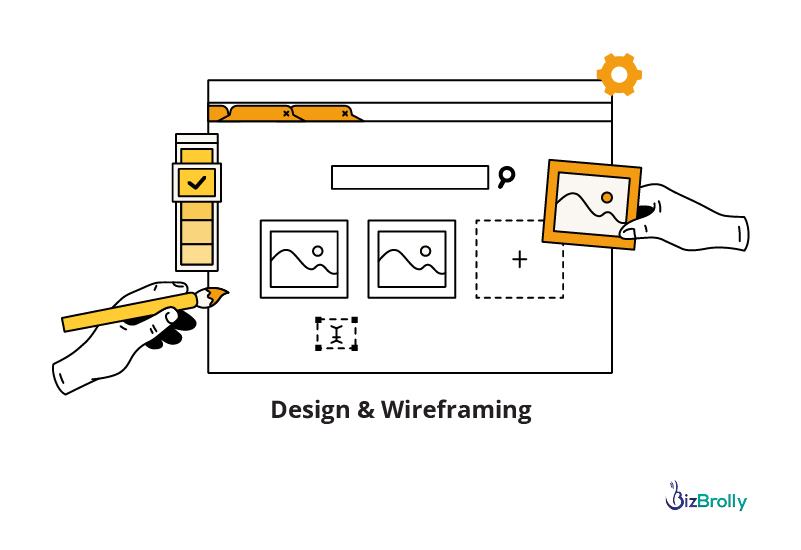
Prototyping Tools: Use prototyping tools like Sketch, Figma, or Adobe XD to create an interactive version of your design. The prototype will be non-functional but will give stakeholders a sense of the product’s look and feel.
Feedback Gathering: The prototype is shared with stakeholders, potential users, or investors to get feedback on the design and usability. This feedback helps refine the product’s visual elements and user experience.
Iterative Changes: Based on the feedback, you may make necessary design changes and create multiple iterations to ensure the design meets user expectations.
Time & Cost: The development time for a prototype is generally shorter and less expensive. It can take a few weeks to a couple of months depending on the complexity of the design.
Market Research & Idea Validation: Before building an MVP, you need to conduct market research to validate the need for your product. This helps in identifying the core features necessary to solve the user’s problem.
Feature Prioritization: Select the essential features that address the main pain points of users. This involves understanding the core functionalities your product must have to be useful and valuable to your target audience.
Design & Prototyping: Although the MVP includes more functionality, it still requires a design phase to ensure the user interface is clean and intuitive. Prototypes or wireframes can be used here to outline the basic design.
Development: With an MVP, development involves creating a working product with essential features. This phase includes coding and programming to bring the product to life.
Testing & Debugging: Thorough testing is done to ensure the MVP functions as expected. This includes testing core features and identifying bugs that could affect user experience.
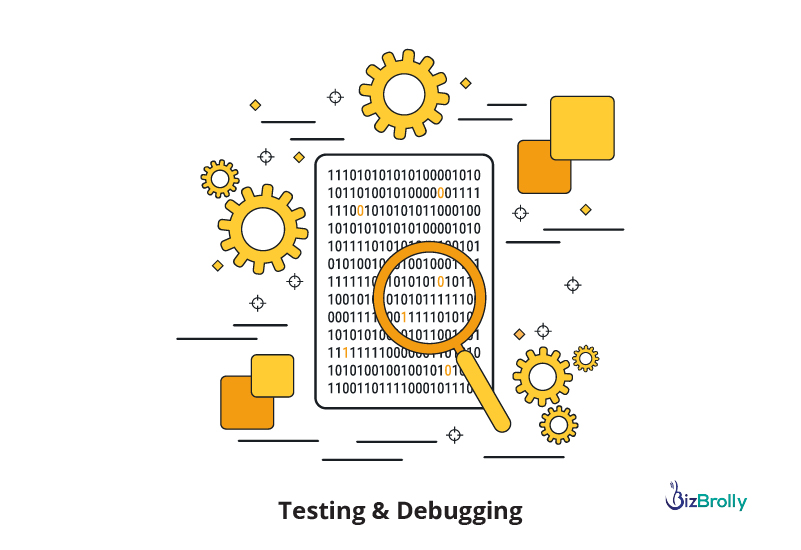
Launch & Feedback: The MVP is then released to a limited audience or early adopters. You collect user feedback to understand what works, what doesn’t, and which features need improvement.
Iterative Updates: Based on feedback, the product is updated and improved. This feedback loop continues until the product matures and more features are added.
Time & Cost: MVP development can take several months and involves a higher budget compared to a prototype. However, it is a more complete product that enables you to gather valuable market feedback.
Choosing between a prototype and a minimum viable product (MVP) ultimately depends on where you are in your product development journey and what goals you aim to achieve. If you’re still refining your concept, focusing on design, or testing usability with minimal investment, a prototype is the way to go. It’s a valuable tool for visualizing your ideas, gathering early feedback, and making iterative improvements. However, it doesn’t serve as a functional product and might not offer the deep market insights needed for long-term success.
On the other hand, an MVP allows you to test the market with real-world feedback, validating your product’s value proposition and core features before a full-scale launch. While more resource-intensive, it provides crucial data about user behavior, product performance, and market fit—making it an essential step if you’re serious about scaling your product.
At BizBrolly, we understand the challenges involved in product development. Whether you need help creating a prototype or building a functional MVP, our expertise in custom software development ensures that you can efficiently bring your ideas to life, gather valuable feedback, and make informed decisions as you move forward.
Let BizBrolly be your trusted partner in transforming your product vision into reality. Contact us today to explore how we can help you launch your product with confidence and success.

Did you know that executives don’t receive the data they need 65% of the t...
Explore more
Cloud computing is transforming the manufacturing industry by making it easier t...
Explore more

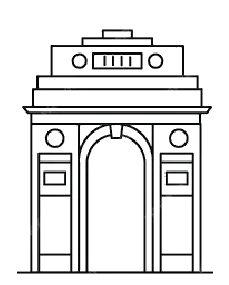
D-23, Sector 63, Noida,
UP - 201307
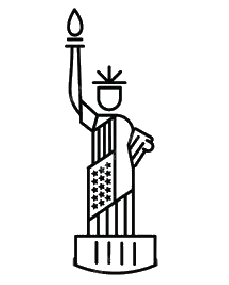
141 Westgate Dr, Edison,
NJ - 08820
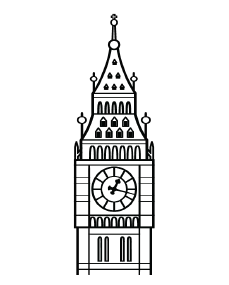
4 Black lion court, Mill road, Kent, UK – ME71HL
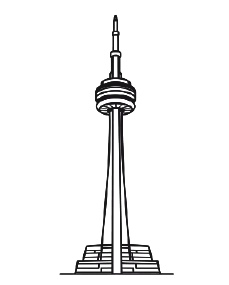
2207, 2220 Lakeshore Blvd W, Toronto ON- M8V0C1
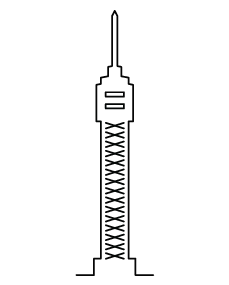
94A Central Road, Jacanlee, Johannesburg 2194